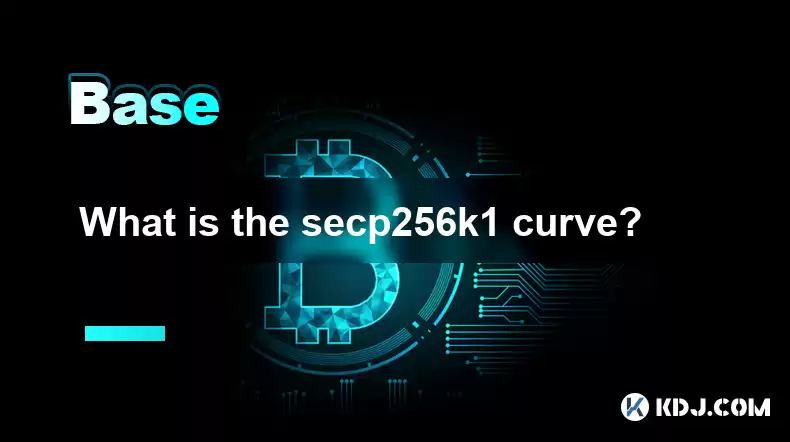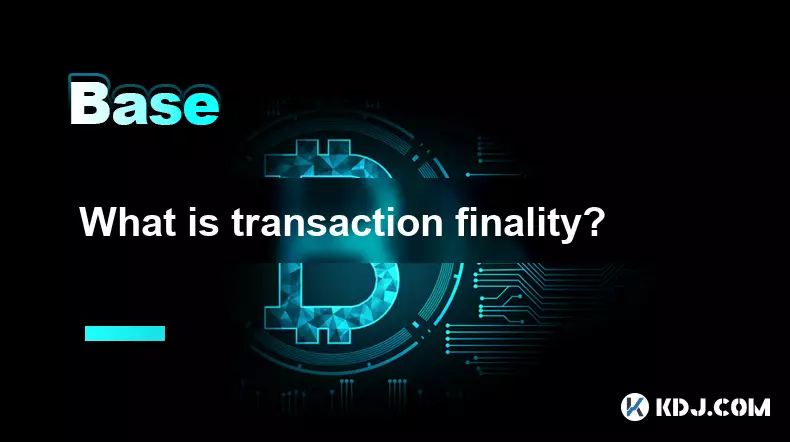-
 bitcoin
bitcoin $116750.837634 USD
1.11% -
 ethereum
ethereum $4515.341020 USD
-0.47% -
 xrp
xrp $3.043113 USD
1.49% -
 tether
tether $1.000476 USD
0.02% -
 bnb
bnb $959.123861 USD
4.03% -
 solana
solana $236.571244 USD
0.47% -
 usd-coin
usd-coin $1.000002 USD
0.00% -
 dogecoin
dogecoin $0.269342 USD
-0.14% -
 tron
tron $0.343000 USD
-0.81% -
 cardano
cardano $0.880538 USD
1.74% -
 hyperliquid
hyperliquid $54.247044 USD
1.00% -
 chainlink
chainlink $23.521588 USD
-0.41% -
 ethena-usde
ethena-usde $1.001241 USD
0.01% -
 sui
sui $3.597422 USD
1.64% -
 avalanche
avalanche $30.081531 USD
1.20%
What is the secp256k1 curve?
The secp256k1 curve is crucial for Bitcoin's cryptography, enabling secure key generation and transaction signing through elliptic curve methods.
Apr 08, 2025 at 04:07 am

The secp256k1 curve is a fundamental component in the world of cryptocurrencies, particularly in the Bitcoin network. It is an elliptic curve used for cryptographic operations, specifically for generating public keys from private keys and for signing transactions. Understanding the secp256k1 curve is crucial for anyone interested in the technical underpinnings of Bitcoin and other cryptocurrencies that utilize similar cryptographic methods.
What is an Elliptic Curve?
An elliptic curve is a mathematical concept used in cryptography to provide secure key generation and digital signatures. Elliptic curve cryptography (ECC) is favored in the cryptocurrency space because it offers a high level of security with relatively smaller key sizes compared to other cryptographic systems like RSA. The secp256k1 curve is one specific type of elliptic curve defined by a set of parameters that dictate its shape and properties.
The Parameters of secp256k1
The secp256k1 curve is defined by the following parameters:
- Field size (p): 2^256 - 2^32 - 2^9 - 2^8 - 2^7 - 2^6 - 2^4 - 1
- Curve coefficients (a, b): a = 0, b = 7
- Base point (G): Gx = 79BE667EF9DCBBAC55A06295CE870B07029BFCDB2DCE28D959F2815B16F81798, Gy = 483ADA7726A3C4655DA4FBFC0E1108A8FD17B448A68554199C47D08FFB10D4B8
- Order of the base point (n): FFFFFFFF FFFFFFFF FFFFFFFF FFFFFFFE BAAEDCE6 AF48A03B BFD25E8C D0364141
These parameters define the curve's equation and the points on the curve used for cryptographic operations.
How secp256k1 is Used in Bitcoin
In Bitcoin, the secp256k1 curve is used to generate public keys from private keys and to create digital signatures for transactions. Here's how it works:
Private Key to Public Key: A private key is a randomly generated 256-bit number. This private key is used with the secp256k1 curve to generate a public key. The process involves multiplying the private key by the base point G on the curve. The result is a point on the curve, which is the public key.
Digital Signatures: When a user wants to sign a transaction, they use their private key to create a signature. This signature is generated using the Elliptic Curve Digital Signature Algorithm (ECDSA) with the secp256k1 curve. The signature can be verified by anyone using the corresponding public key, ensuring the transaction's authenticity and integrity.
Security of secp256k1
The security of the secp256k1 curve is based on the difficulty of solving the elliptic curve discrete logarithm problem (ECDLP). This problem involves finding the private key given the public key, which is computationally infeasible with current technology. The secp256k1 curve is designed to provide a high level of security, making it suitable for use in cryptocurrencies where security is paramount.
Implementation and Libraries
Several libraries and tools have been developed to work with the secp256k1 curve, making it easier for developers to implement cryptographic operations in their applications. Some of the most popular libraries include:
- libsecp256k1: An optimized C library for the secp256k1 curve, widely used in Bitcoin and other cryptocurrencies.
- Bitcoin Core: The reference implementation of the Bitcoin protocol, which includes secp256k1 operations.
- Cryptography libraries: Many general-purpose cryptography libraries, such as OpenSSL, support the secp256k1 curve.
These libraries provide functions for key generation, signature creation, and verification, making it easier for developers to integrate secp256k1 into their applications.
Practical Example: Generating a Bitcoin Address
To illustrate how the secp256k1 curve is used in practice, let's walk through the process of generating a Bitcoin address:
Generate a Private Key: Start by generating a random 256-bit number. This number is your private key.
Generate a Public Key: Use the private key to perform a point multiplication on the secp256k1 curve with the base point G. The result is a point on the curve, which is your public key.
Compress the Public Key: The public key can be compressed to save space. The compressed public key is a 33-byte value.
Hash the Public Key: Apply the SHA-256 hash function to the compressed public key, followed by the RIPEMD-160 hash function. The result is a 20-byte hash, known as the public key hash.
Add Version Byte: Prepend a version byte (0x00 for Bitcoin) to the public key hash.
Calculate Checksum: Perform a double SHA-256 hash on the version byte and public key hash. Take the first 4 bytes of the result as the checksum.
Concatenate and Encode: Concatenate the version byte, public key hash, and checksum. Encode the result using Base58Check encoding to get the final Bitcoin address.
Here's a more detailed breakdown of the steps:
Generate a Private Key:
- Use a cryptographically secure random number generator to generate a 256-bit number.
Generate a Public Key:
- Multiply the private key by the base point G on the secp256k1 curve.
- The result is a point (x, y) on the curve.
Compress the Public Key:
- If the y-coordinate is even, the compressed public key is 02 followed by the x-coordinate.
- If the y-coordinate is odd, the compressed public key is 03 followed by the x-coordinate.
Hash the Public Key:
- Apply SHA-256 to the compressed public key.
- Apply RIPEMD-160 to the result of the SHA-256 hash.
Add Version Byte:
- Prepend 0x00 to the public key hash.
Calculate Checksum:
- Perform a double SHA-256 hash on the version byte and public key hash.
- Take the first 4 bytes of the result as the checksum.
Concatenate and Encode:
- Concatenate the version byte, public key hash, and checksum.
- Encode the result using Base58Check encoding.
Frequently Asked Questions
Q: Why is the secp256k1 curve used in Bitcoin instead of other elliptic curves?A: The secp256k1 curve was chosen for Bitcoin because it provides a good balance between security and performance. It is designed to be efficient for the operations required in Bitcoin, such as key generation and signature verification. Additionally, the curve's parameters were selected to avoid potential vulnerabilities that have been identified in other curves.
Q: Can the secp256k1 curve be used in other cryptocurrencies?A: Yes, the secp256k1 curve is not exclusive to Bitcoin and can be used in other cryptocurrencies. Many altcoins and blockchain projects use the same curve for their cryptographic operations due to its proven security and efficiency.
Q: What are the potential risks associated with the secp256k1 curve?A: While the secp256k1 curve is considered secure, there are potential risks associated with any cryptographic system. These include the possibility of advances in mathematics or computing power that could make solving the ECDLP easier, as well as implementation errors in software that could lead to vulnerabilities.
Q: How can I verify the security of a secp256k1 implementation?A: To verify the security of a secp256k1 implementation, you can use cryptographic libraries that have been audited and tested by the community. Additionally, you can perform your own tests by generating keys and signatures and verifying them using different tools to ensure consistency and correctness.
Disclaimer:info@kdj.com
The information provided is not trading advice. kdj.com does not assume any responsibility for any investments made based on the information provided in this article. Cryptocurrencies are highly volatile and it is highly recommended that you invest with caution after thorough research!
If you believe that the content used on this website infringes your copyright, please contact us immediately (info@kdj.com) and we will delete it promptly.
- Symbiotic, Chainlink, and Bitcoin Security: A New Era for Cross-Chain Transfers
- 2025-09-17 12:25:12
- PEPE, Litecoin, BlockDAG: Decoding the Hype and the Hardware
- 2025-09-17 08:45:15
- Decentralized Exchanges Surge: Trading Volume and Crypto Platforms in the Spotlight
- 2025-09-17 08:45:15
- DOGE ETF Buzz, BlockDAG Presale Surge, and Ondo PosRO: What's Hot in Crypto?
- 2025-09-17 08:50:01
- Bitcoin, MSTR, NAKA: Navigating the Wild Ride of Crypto Treasuries
- 2025-09-17 09:05:12
- Solana ETF Incoming? Institutional Capital Eyes $750 SOL
- 2025-09-17 09:05:12
Related knowledge

What is the creator economy?
Sep 10,2025 at 02:54am
Understanding the Creator Economy in the Digital Age1. The creator economy refers to a digital ecosystem where individuals produce content, build audi...

What is social recovery for wallets?
Sep 09,2025 at 09:54am
Understanding Social Recovery in Cryptocurrency Wallets1. Social recovery is a security mechanism designed to help users regain access to their crypto...

What is an RPC node?
Sep 17,2025 at 12:00am
Understanding the Role of RPC Nodes in Blockchain Networks1. An RPC (Remote Procedure Call) node serves as a communication bridge between blockchain u...

What is a blockchain API?
Sep 16,2025 at 05:54pm
Understanding Blockchain APIs1. A blockchain API is a set of protocols and tools that allow software applications to interact with a blockchain networ...

What is a crypto payment gateway?
Sep 14,2025 at 06:36pm
Understanding the Role of a Crypto Payment Gateway1. A crypto payment gateway is a technological solution that enables merchants to accept digital cur...

What is transaction finality?
Sep 16,2025 at 11:19pm
Understanding Transaction Finality in BlockchainTransaction finality refers to the point at which a blockchain transaction becomes irreversible and is...

What is the creator economy?
Sep 10,2025 at 02:54am
Understanding the Creator Economy in the Digital Age1. The creator economy refers to a digital ecosystem where individuals produce content, build audi...

What is social recovery for wallets?
Sep 09,2025 at 09:54am
Understanding Social Recovery in Cryptocurrency Wallets1. Social recovery is a security mechanism designed to help users regain access to their crypto...

What is an RPC node?
Sep 17,2025 at 12:00am
Understanding the Role of RPC Nodes in Blockchain Networks1. An RPC (Remote Procedure Call) node serves as a communication bridge between blockchain u...

What is a blockchain API?
Sep 16,2025 at 05:54pm
Understanding Blockchain APIs1. A blockchain API is a set of protocols and tools that allow software applications to interact with a blockchain networ...

What is a crypto payment gateway?
Sep 14,2025 at 06:36pm
Understanding the Role of a Crypto Payment Gateway1. A crypto payment gateway is a technological solution that enables merchants to accept digital cur...

What is transaction finality?
Sep 16,2025 at 11:19pm
Understanding Transaction Finality in BlockchainTransaction finality refers to the point at which a blockchain transaction becomes irreversible and is...
See all articles
























![Web3 Crypto Market Morning News: The market rose slightly and waited for interest rate cuts in the early morning of tomorrow. Binance Alpha made another big hair. Bnb chain Meme soared, Xlayer pulled back across the board [Vic TALK Issue 1417] Web3 Crypto Market Morning News: The market rose slightly and waited for interest rate cuts in the early morning of tomorrow. Binance Alpha made another big hair. Bnb chain Meme soared, Xlayer pulled back across the board [Vic TALK Issue 1417]](/uploads/2025/09/17/cryptocurrencies-news/videos/web-crypto-market-morning-news-market-rose-waited-rate-cuts-morning-tomorrow-binance-alpha-hair-bnb-chain-meme-soared-xlayer-pulled-board-vic-talk-issue/68ca0824b9338_image_500_375.webp)
















































